Systematic Literature Review of the Natural Environment of the Coromandel Peninsula, New Zealand, from a Conservation Perspective
Abstract
1. Introduction
2. Materials and Methods
Methodology
3. Results
3.1. Scopus Database and Results of Assessment
3.2. Web of Science Database and Results of Assessment
3.3. JSTOR Database and Results of Assessment
4. Discussion
5. Conclusions
Supplementary Materials
Author Contributions
Funding
Institutional Review Board
Informed Consent Statement
Acknowledgments
Conflicts of Interest
References
- Wiltshier, P. Community-based tourism–the kiwi variation. In Community-Based Tourism in the Developing World; Routledge: Oxfordshire, UK, 2019; pp. 166–175. [Google Scholar]
- Holzapfel, R. Modelling Sustainable Ecotourism Development on the Coromandel Peninsula in Aotearoa/New Zealand; a Holistic Systems Approach Based on the Idea of Chaos and Complexity in a Human-Activity System. Ph.D. Thesis, The University of Waikato, Hamilton, New Zealand, 2003. [Google Scholar]
- Hall, C.M. Nature Tourism Seminar. J. Sustain. Tour. 1993, 1, 143–144. [Google Scholar] [CrossRef]
- Matthews, Y.; Scarpa, R.; Marsh, D. Cumulative attraction and spatial dependence in a destination choice model for beach recreation. Tour. Manag. 2018, 66, 318–328. [Google Scholar] [CrossRef]
- Dudding, V.; Ryan, C. The impacts of tourism on a rural retail sector: A New Zealand case study. Tour. Econ. 2000, 6, 301–319. [Google Scholar] [CrossRef]
- Adams, C. Sustainable Tourism: New Zealand-Aotearoa. 2010, p. 31. Available online: https://core.ac.uk/download/pdf/71975042.pdf (accessed on 14 September 2021).
- Hayward, B.W. Out of the Ocean, Into the Fire: History in the Rocks, Fossils and Landforms of Auckland, Northland and Coromandel; Geoscience Society of New Zealand: Lower Hutt, New Zealand, 2017; p. 336.
- Adams, C.; Graham, I.; Seward, D.; Skinner, D.; Adams, C.; Skinner, D.; Moore, P. Geochronological and geochemical evolution of late Cenozoic volcanism in the Coromandel Peninsula, New Zealand. N. Z. J. Geol. Geophys. 1994, 37, 359–379. [Google Scholar] [CrossRef]
- Bell, B.D. A review of the status of New Zealand Leiopelma species (Anura: Leiopelmatidae), including a summary of demographic studies in Coromandel and on Maud Island. N. Z. J. Zool. 1994, 21, 341–349. [Google Scholar] [CrossRef][Green Version]
- Homer, L.; Moore, P.R. Vanishing Volcanoes: A Guide to the Landforms and Rock Formations of Coromandel Peninsula; Landscape Publications: Wellington, New Zealand, 1992; p. 97. [Google Scholar]
- Morley, M.S.; Hayward, B.W. Biogeography and biodiversity of intertidal micromollusca of northern New Zealand. Rec. Auckl. Mus. 2016, 51, 55–77. [Google Scholar]
- What to Plant in Coromandel Ecological Region. Available online: https://www.waikatoregion.govt.nz/assets/WRC/Environment/Natural-Resources/Biodiversity/planting-guides/WRC-Coromandel-planting-guide-part1.pdf (accessed on 12 September 2021).
- Clement, A.J.; Nováková, T.; Hudson-Edwards, K.A.; Fuller, I.C.; Macklin, M.G.; Fox, E.G.; Zapico, I. The environmental and geomorphological impacts of historical gold mining in the Ohinemuri and Waihou river catchments, Coromandel, New Zealand. Geomorphology 2017, 295, 159–175. [Google Scholar] [CrossRef]
- Legget, J. Mining the mining museum on New Zealand’s North Island: Rich veins of dissent. In Mining Heritage and Tourism; Routledge: Oxfordshire, UK, 2010; pp. 79–93. [Google Scholar]
- Rudzitis, G.; Bird, K. The myth and reality of sustainable New Zealand: Mining in a pristine land. Environ. Sci. Policy Sustain. Dev. 2011, 53, 16–28. [Google Scholar] [CrossRef]
- Craw, D.; Chappell, D. Metal redistribution in historic mine wastes, Coromandel Peninsula, New Zealand. N. Z. J. Geol. Geophys. 2000, 43, 187–198. [Google Scholar] [CrossRef]
- Goldmining in the Coromandel. Available online: https://archives.govt.nz/discover-our-stories/goldmining-in-the-coromandel (accessed on 12 September 2021).
- The History of Gold Mining on “The River Thames”. Available online: http://www.ohinemuri.org.nz/journals/9-journal-1-june-1964/46-the-history-of-gold-mining-on-the-river-thames (accessed on 12 September 2021).
- Christie, A.B.; Simpson, M.P.; Brathwaite, R.L.; Mauk, J.L.; Simmons, S.F. Epithermal Au-Ag and related deposits of the Hauraki goldfield, Coromandel volcanic zone, New Zealand. Econ. Geol. 2007, 102, 785–816. [Google Scholar] [CrossRef]
- John, D.A. Epithermal gold-silver deposits of the Hauraki Goldfield, New Zealand: An introduction. Econ. Geol. 2011, 106, 915–919. [Google Scholar] [CrossRef]
- Rabone, S.; Moore, D.; Barker, R. Geology of the Wharekirauponga epithermal gold deposit, Coromandel region. Miner. Depos. N. Z. 1989, 13, 93–97. [Google Scholar]
- De Ronde, C.E.; Blattner, P. Hydrothermal alteration, stable isotopes, and fluid inclusions of the Golden Cross epithermal gold-silver deposit, Waihi, New Zealand. Econ. Geol. 1988, 83, 895–917. [Google Scholar] [CrossRef]
- Walter, R.; Buckley, H.; Jacomb, C.; Matisoo-Smith, E. Mass migration and the Polynesian settlement of New Zealand. J. World Prehistory 2017, 30, 351–376. [Google Scholar] [CrossRef]
- Ladefoged, T.N.; Gemmell, C.; McCoy, M.; Jorgensen, A.; Glover, H.; Stevenson, C.; O’Neale, D. Social network analysis of obsidian artefacts and Māori interaction in northern Aotearoa New Zealand. PLoS ONE 2019, 14, e0212941. [Google Scholar] [CrossRef]
- Brilha, J.; Reynard, E. Geoheritage and geoconservation: The challenges. Geoheritage 2018, 7. [Google Scholar] [CrossRef]
- Brilha, J. Geoheritage: Inventories and evaluation. In Geoheritage; Elsevier: Amsterdam, The Netherlands, 2018; pp. 69–85. [Google Scholar]
- Brilha, J. Inventory and quantitative assessment of geosites and geodiversity sites: A review. Geoheritage 2016, 8, 119–134. [Google Scholar] [CrossRef]
- Tavares, G.N.D.; Boggiani, P.C.; de Moraes Leme, J.; Trindade, R.I. The inventory of the geological and paleontological sites in the area of the aspirant Geopark Bodoquena-Pantanal in Brazil. Geoheritage 2020, 12, 1–22. [Google Scholar] [CrossRef]
- Reverte, F.C.; Garcia, M.d.G.M.; Brilha, J.; Pellejero, A.U. Assessment of impacts on ecosystem services provided by geodiversity in highly urbanised areas: A case study of the Taubaté Basin, Brazil. Environ. Sci. Policy 2020, 112, 91–106. [Google Scholar] [CrossRef]
- dos Santos, W.F.S.; de Souza Carvalho, I.; Brilha, J. Public understanding on geoconservation strategies at the Passagem das Pedras Geosite, Paraiba (Brazil): Contribution to the Rio do Peixe Geopark proposal. Geoheritage 2019, 11, 2065–2077. [Google Scholar] [CrossRef]
- Reynard, E.; Brilha, J. Geoheritage: A multidisciplinary and applied research topic. In Geoheritage; Elsevier: Amsterdam, The Netherlands, 2018; pp. 3–9. [Google Scholar]
- Prosser, C.D.; Díaz-Martínez, E.; Larwood, J.G. The conservation of geosites: Principles and practice. In Geoheritage; Elsevier: Amsterdam, The Netherlands, 2018; pp. 193–212. [Google Scholar]
- Gray, M. Geodiversity: The backbone of geoheritage and geoconservation. In Geoheritage; Elsevier: Amsterdam, The Netherlands, 2018; pp. 13–25. [Google Scholar]
- Falagas, M.E.; Pitsouni, E.I.; Malietzis, G.A.; Pappas, G. Comparison of PubMed, Scopus, web of science, and Google scholar: Strengths and weaknesses. FASEB J. 2008, 22, 338–342. [Google Scholar] [CrossRef]
- Henzinger, M.; Lawrence, S. Extracting knowledge from the world wide web. Proc. Natl. Acad. Sci. USA 2004, 101, 5186–5191. [Google Scholar] [CrossRef]
- Banks, M.A. The excitement of Google Scholar, the worry of Google Print. Biomed. Digit. Libr. 2005, 2, 1–3. [Google Scholar] [CrossRef]
- Denyer, D.; Tranfield, D. Producing a systematic review. Sage Handb. Organ. Res. Methods 2009, 39, 671–689. [Google Scholar]
- Rǎdulescu, D.; Sǎndulescu, M. The plate-tectonics concept and the geological structure of the Carpathians. Tectonophysics 1973, 16, 155–161. [Google Scholar] [CrossRef]
- Fielitz, W.; Seghedi, I. Late Miocene–Quaternary volcanism, tectonics and drainage system evolution in the East Carpathians, Romania. Tectonophysics 2005, 410, 111–136. [Google Scholar] [CrossRef]
- Melinte-Dobrinescu, M.C.; Brustur, T.; Jipa, D.; Macaleţ, R.; Ion, G.; Ion, E.; Popa, A.; Stănescu, I.; Briceag, A. The geological and palaeontological heritage of the Buzău Land Geopark (Carpathians, Romania). Geoheritage 2017, 9, 225–236. [Google Scholar] [CrossRef]
- Melinte-Dobrinescu, M.C.; Brustur, T.; Gabriel, I.; Macalet, R.; Briceag, A.; Elena, I.; Adrian, P.; Rotaru, S. Geological investigations and mapping in the Buzău Land Geopark: State of the art. Geo-Eco-Mar. 2017, 23, 133–144. [Google Scholar] [CrossRef]
- Brocx, M.; Semeniuk, V. Geology: From Antiquity to Modern Day Geoheritage and Geoconservation, with Britain as a case study. In From Geoheritage to Geoparks; Springer: Berlin/Heidelberg, Germany, 2015; pp. 35–53. [Google Scholar]
- Brush, S.G. History of science and science education. Interchange 1989, 20, 60–70. [Google Scholar] [CrossRef]
- Oszlányi, J.; Grodzińska, K.; Badea, O.; Shparyk, Y. Nature conservation in Central and Eastern Europe with a special emphasis on the Carpathian Mountains. Environ. Pollut. 2004, 130, 127–134. [Google Scholar] [CrossRef]
- Cunningham, C. A framework for addressing Māori knowledge in research, science and technology. Pac. Health Dialog 2000, 7, 62–69. [Google Scholar] [PubMed]
- Harmsworth, G.R.; Awatere, S. Indigenous Māori knowledge and perspectives of Ecosystems. In Ecosystem Services in New Zealand—Conditions and Trends; Manaaki Whenua Press: Lincoln, New Zealand, 2013; pp. 274–286. [Google Scholar]
- Salmond, A. Two Worlds: First Meetings between Maori and Europeans, 1642–1772; University of Hawaii Press: Honolulu, HI, USA, 1992. [Google Scholar]
- Schaniel, W.C. European technology and the New Zealand Maori economy: 1769–1840. Soc. Sci. J. 2001, 38, 137–146. [Google Scholar] [CrossRef]
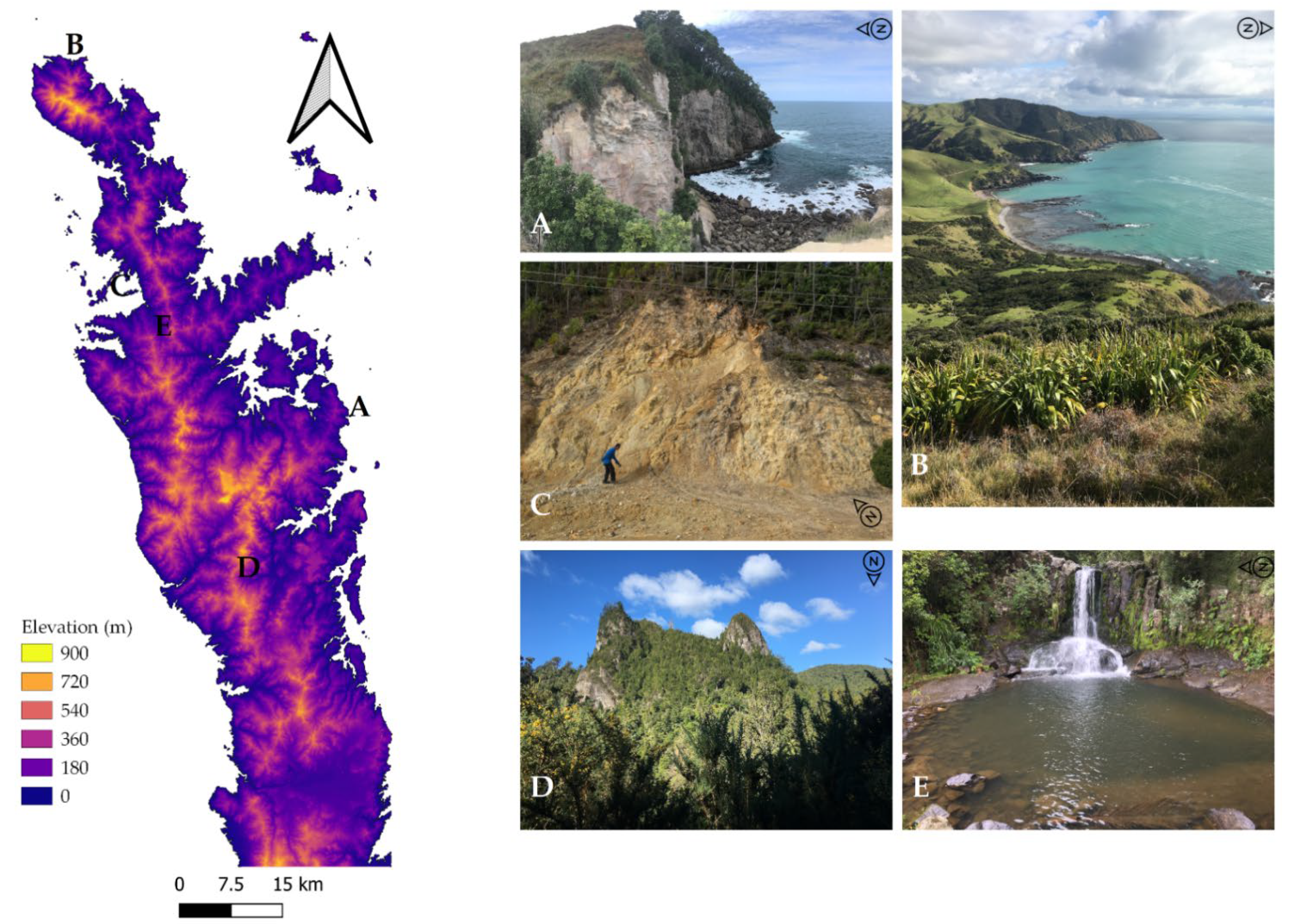
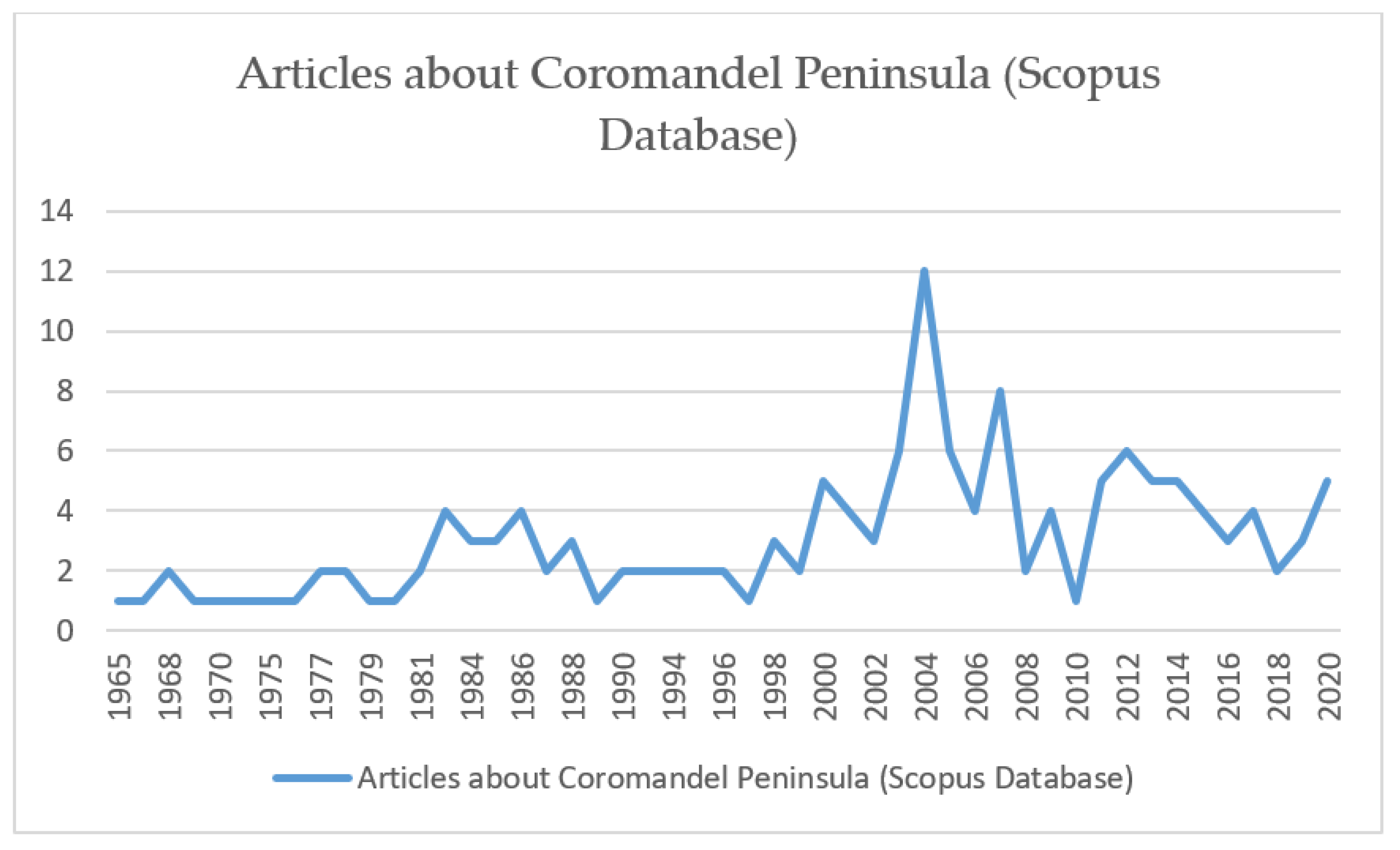
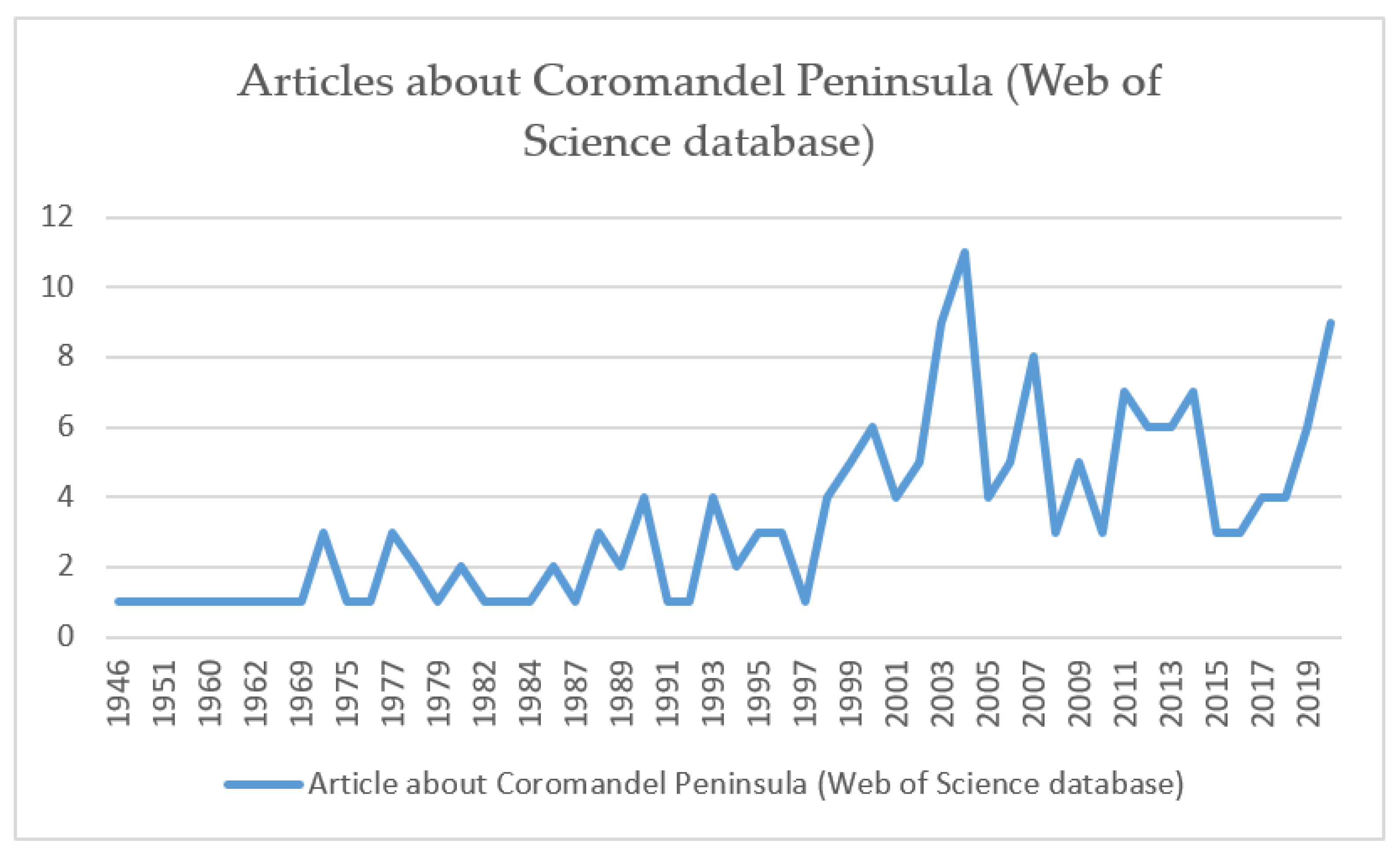
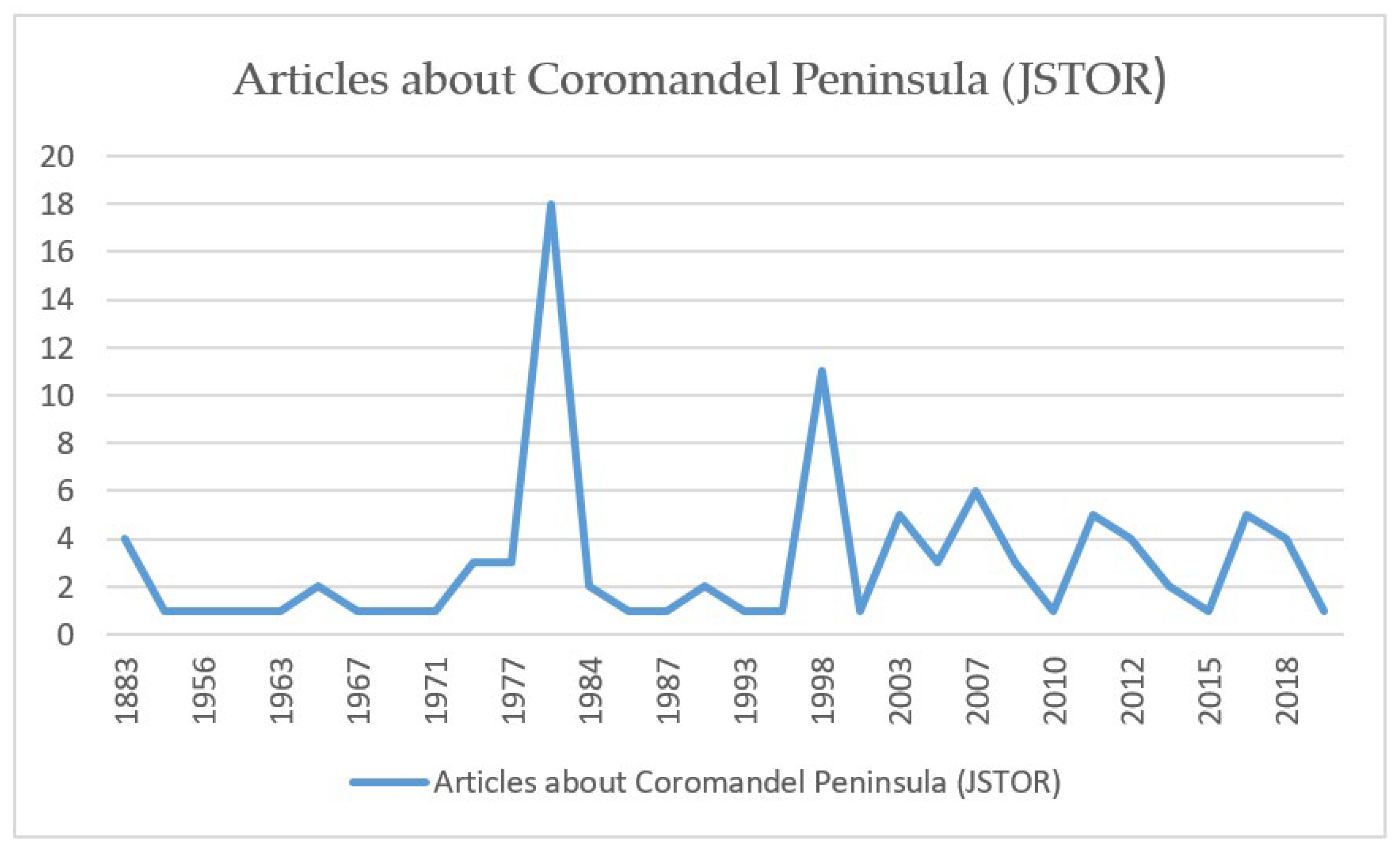
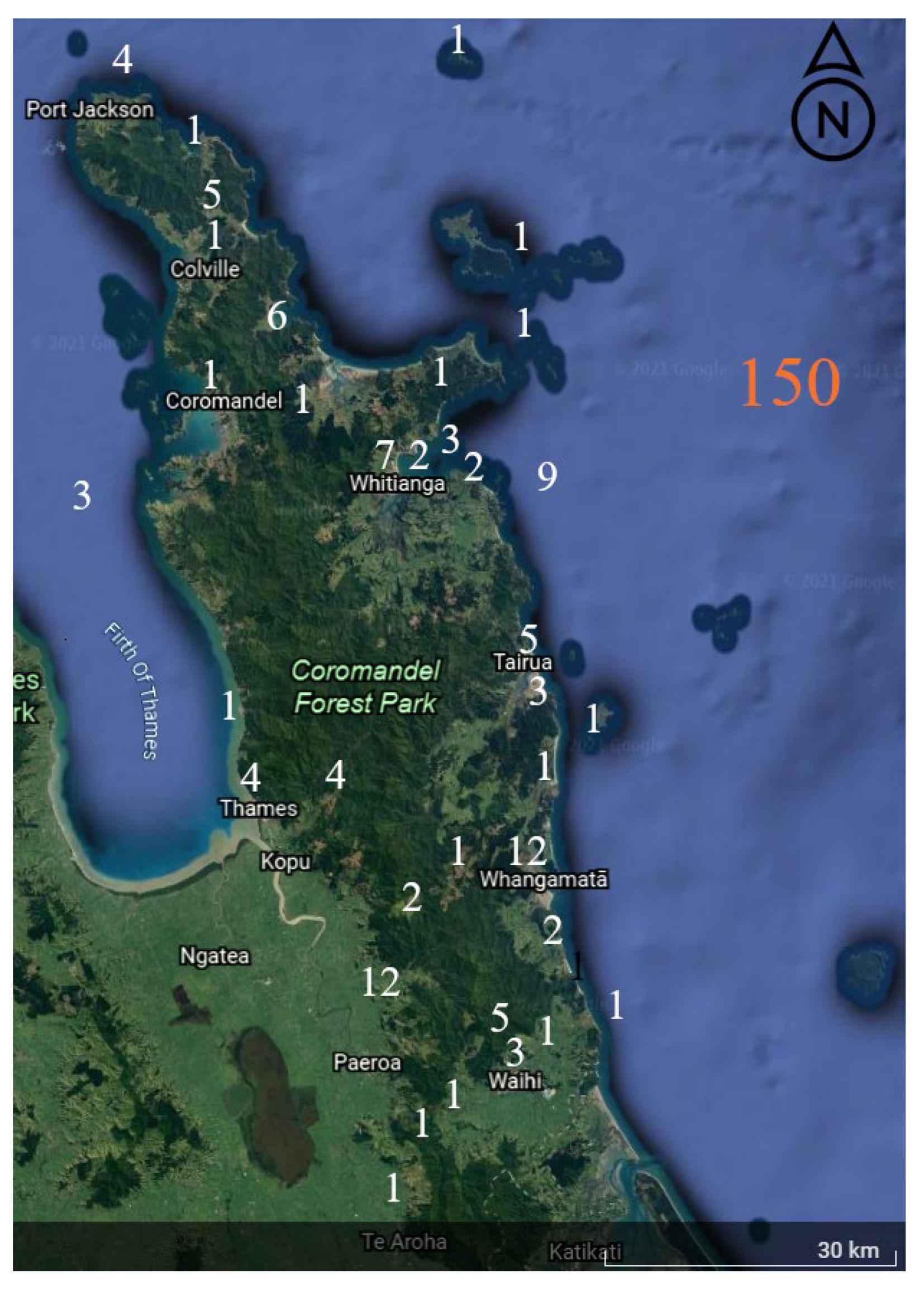
| Sources | Scopus | Web of Science | JSTOR |
|---|---|---|---|
| Search types | Article, Title, Abstract, Keyword | Topic | Author, Item title, Abstract, Caption |
| The word/phrase of search | “Coromandel Peninsula” (As an additional “New Zealand”) | “Coromandel Peninsula” (As an additional “New Zealand”) | (“Coromandel Peninsula”) AND (“New Zealand”) |
| Date of search | 14 September 2021 | 14 September 2021 | 14 September 2021 |
| Results | 150 documents | 180 documents | 357 documents, 2 pictures |
| Exported information | Citation information (Full) and Abstract, Keywords (Full) | Author, Title, Source, and Abstract | Author, Title, Source, and Abstract |
| Additional data | The areas of research | The areas of research | The areas of research |
Author Keywords | |
| 34 New Zealand | 3 Maori |
| 14 Coromandel Peninsula | 3 Hydrothermal alteration |
| 7 Coromandel | 3 Holocene |
| 5 Geochemistry | 3 Coromandel Volcanic Zone |
| 4 Taxonomy | 3 Aotearoa New Zealand |
| 4 Northland | 2 Waihi ash |
| 4 New Zealand flora | 2 Volcanism |
| 4 Miocene | 2 Tuhua tephra formation |
| 4 Ignimbrite | 2 Tsunami |
| 4 Great Barrier Island | 2 Tephrochronology |
| 3 Whangamata ash | 2 Tephra |
| 3 Volcanic rocks | 2 Tectonics |
| 3 Riparian vegetation | 2 Succineidae |
| 3 Rhyolite | 2 Succinea archeyi |
| 3 Radiata pine | 2 Structure |
| 3 pXRF | 2 Stream |
| 3 Porifera | 2 Stratigraphy |
| 3 Palynology | 2 Spongiidae |
| 3 Obsidian | 2 Spongia |
Index Keywords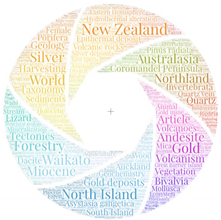 | |
| 107 New Zealand | 6 Volcanism |
| 59 North Island | 6 Tectonics |
| 54 Coromandel Peninsula | 6 Taxonomy |
| 47 Waikato | 6 South Island |
| 33 Australasia | 6 Silver |
| 20 Asystasia gangetica | 6 Pinus radiata |
| 11 Hydrothermal alterations | 6 Invertebrata |
| 10 Gold deposits | 6 Great Barrier Island |
| 10 Forestry | 5 Volcanoes |
| 9 Gold | 5 Vegetation |
| 9 Epithermal deposit | 5 Silver deposits |
| 8 World | 5 Sediments |
| 8 Northland | 5 Quartz vein |
| 8 Miocene | 5 Mineralization |
| 8 Harvesting | 5 Geology |
| 8 Eastern Hemisphere | 5 Bivalvia |
| 8 Andesite | 5 Auckland |
| 7 Volcanic rocks | 5 Article |
| 7 Geochemistry | 5 Aquaculture |
| Number of Articles | The Area of Research |
|---|---|
| 71 | Earth and Planetary Sciences |
| 54 | Agricultural and Biological Sciences |
| 43 | Environmental Science |
| 15 | Social Sciences |
| 8 | Arts and Humanities |
| 7 | Multidisciplinary |
| 4 | Engineering |
| 3 | Chemical Engineering |
| 3 | Medicine |
| 2 | Biochemistry, Genetics and Molecular Biology |
| 2 | Energy |
| 1 | Business, Management and Accounting |
| 1 | Chemistry |
| 1 | Computer Science |
| 1 | Mathematics |
| 1 | Nursing |
| 1 | Pharmacology, Toxicology and Pharmaceutics |
| Number of Articles | The Area of Research |
|---|---|
| 96 | Environmental Sciences Ecology |
| 68 | Zoology |
| 44 | Life Sciences Biomedicine Other Topics |
| 39 | Biodiversity Conservation |
| 39 | Geology |
| 35 | Physical Sciences Other Topics |
| 34 | Plant Sciences |
| 32 | Marine Freshwater Biology |
| 27 | Forestry |
| 23 | Agriculture |
| 20 | Palaeontology |
| 19 | Geochemistry Geophysics |
| 18 | Anatomy Morphology |
| 18 | Meteorology Atmospheric Sciences |
| 15 | Oceanography |
| 14 | Geography |
| 13 | Nutrition Dietetics |
| 12 | Developmental Biology |
| 12 | Fisheries |
| 12 | Physiology |
| 12 | Science Technology Other Topics |
| 11 | Anthropology |
| 11 | Biochemistry Molecular Biology |
| 10 | Evolutionary Biology |
| Number of Articles | The Area of Research |
|---|---|
| 183 | Ecology & Evolutionary Biology |
| 77 | Biological Sciences |
| 75 | Asian Studies |
| 58 | Anthropology |
| 48 | Archaeology |
| 42 | Aquatic Sciences |
| 20 | Botany & Plant Sciences |
| 13 | Geography |
| 13 | History |
| 13 | History of Science & Technology |
| 12 | Environmental Science |
| 10 | Zoology |
| 5 | Geology |
| 5 | Palaeontology |
| 4 | Education |
| 3 | Art & Art History |
| 3 | Business |
| 3 | Language & Literature |
| 3 | Political Science |
| 2 | Economics |
| 2 | Linguistics |
| 2 | Sociology |
| Authors | Title | Year |
|---|---|---|
| Hitchmough R.A., Nielsen S.V., Bauer A.M. | Earning your stripes: A second species of striped gecko in the New Zealand gecko genus Toropuku (Gekkota: Diplodactylidae) | 2020 |
| Dowding J.E. | Changes in the number and distribution of northern New Zealand dotterels (Charadrius obscurus aquilonius): results of four censuses undertaken between 1989 and 2011 | 2020 |
| Gesing F. | The politics of artificial dunes: Sustainable coastal protection measures and contested socio-natural objects | 2019 |
| Feltrin L., Motta J.G., Al-Obeidat F., Marir F., Bertelli M. | Combining Weights of Evidence Analysis with Feature Extraction—A Case Study from the Hauraki Goldfield, New Zealand | 2016 |
| Ogden J., Dowding J.E. | Population estimates and conservation of the New Zealand dotterel (Charadrius obscurus) on Great Barrier Island, New Zealand | 2013 |
| Gardner-Gee R., Beggs J.R. | Challenges in Food-Web Restoration: An Assessment of the Restoration Requirements of a Honeydew-Gecko Trophic Interaction in the Auckland Region, New Zealand | 2010 |
| Steens M.I., Winter D.J., Morris R., McCartney J., Greenslade P. | New Zealand’s giant Collembola: New information on distribution and morphology for Holacanthella Börner, 1906 (Neanuridae: Uchidanurinae) | 2007 |
| Schwarz A.-M., Morrison M., Hawes I., Halliday J. | Physical and biological characteristics of a rare marine habitat: Sub-tidal seagrass beds of offshore islands | 2006 |
| Neumann D.R., Orams M.B. | Behaviour and ecology of common dolphins (Delphinus delphis) and the impact of tourism in Mercury Bay, North Island, New Zealand | 2005 |
| Brook F.J. | Distribution and conservation status of the dune snail Succinea archeyi Powell (Stylommatophora: Succineidae) in northern New Zealand | 1999 |
Publisher’s Note: MDPI stays neutral with regard to jurisdictional claims in published maps and institutional affiliations. |
© 2021 by the authors. Licensee MDPI, Basel, Switzerland. This article is an open access article distributed under the terms and conditions of the Creative Commons Attribution (CC BY) license (https://creativecommons.org/licenses/by/4.0/).
Share and Cite
Zakharovskyi, V.; Németh, K. Systematic Literature Review of the Natural Environment of the Coromandel Peninsula, New Zealand, from a Conservation Perspective. Conservation 2021, 1, 270-284. https://doi.org/10.3390/conservation1040021
Zakharovskyi V, Németh K. Systematic Literature Review of the Natural Environment of the Coromandel Peninsula, New Zealand, from a Conservation Perspective. Conservation. 2021; 1(4):270-284. https://doi.org/10.3390/conservation1040021
Chicago/Turabian StyleZakharovskyi, Vladyslav, and Károly Németh. 2021. "Systematic Literature Review of the Natural Environment of the Coromandel Peninsula, New Zealand, from a Conservation Perspective" Conservation 1, no. 4: 270-284. https://doi.org/10.3390/conservation1040021
APA StyleZakharovskyi, V., & Németh, K. (2021). Systematic Literature Review of the Natural Environment of the Coromandel Peninsula, New Zealand, from a Conservation Perspective. Conservation, 1(4), 270-284. https://doi.org/10.3390/conservation1040021







